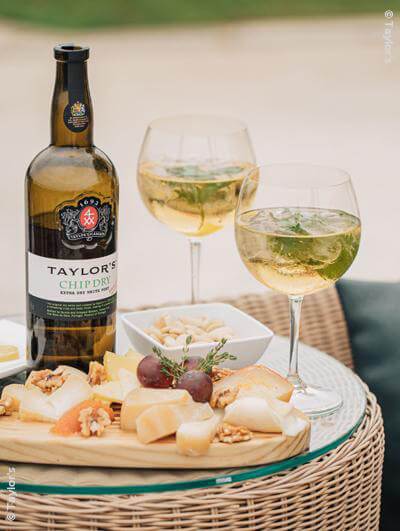
Taylor's : Chip Dry Extra Dry White Port
Pre-arrivals - Stock currently at the producing estate - Available to ship after 14/01/2026
- DeliveryFree standard delivery from $1,000 purchase
- Guaranteed provenanceWines sourced directly from the producing estates
Description
Characteristics and Tasting Tips of Taylor's Chip Dry Extra White Port
Tasting
Appearance
Pale yellow hue with green highlights, a delicate straw color that reflects its carefully controlled aging in oak casks.
Nose
Delicate bouquet revealing fresh fruity fragrances accompanied by mellow aromas and subtle oak notes from its aging.
Palate
Fresh and lively on the attack, offering a beautiful flavor, supported by a dry and crisp finish that characterizes this exceptional white port.
Pairings and Tasting Occasions
Serve chilled between 6°C and 10°C as a traditional aperitif. It pairs perfectly with salted almonds or olives. For a refreshing summer version, serve it over ice with tonic water and a fresh mint leaf, garnished with a twist of lemon.
Mixology
Excellent in a light cocktail, particularly in a "Portonic" mixed with tonic water, ice, and fresh mint. Its distinctive character makes it an ideal base for refreshing summer creations.
An Exceptional Dry White Port from the Douro Valley
Taylor's, Three Centuries of Port Excellence
Founded in 1692 by Job Bearsley, Taylor's is a centuries-old Portuguese wine house specializing in the production of exceptional ports. Based in Vila Nova de Gaia with vineyards in the Douro Valley, notably the prestigious Quinta de Vargellas, Taylor's remains one of the great independent family estates in the sector. Its wines are among the most sought-after at international auctions, reflecting traditional expertise combined with constant innovation.
The Chip Dry Extra White Port, Pioneer of Dry White Ports
As the first dry white port created by Taylor's in 1934, the Chip Dry Extra White Port revolutionizes the traditional rules of port. Made primarily from Malvasia Fina grown in the Douro Superior, east of the Douro Valley, this aperitif white port benefits from a traditional vinification process with the addition of brandy to the must to stop fermentation. Added at a later stage, after much of the sugar has been converted into alcohol, this addition gives the final product the distinctive character that sets it apart. The wines age separately for 4 to 5 years in oak vats before being blended shortly before bottling to achieve the desired balance and character.





